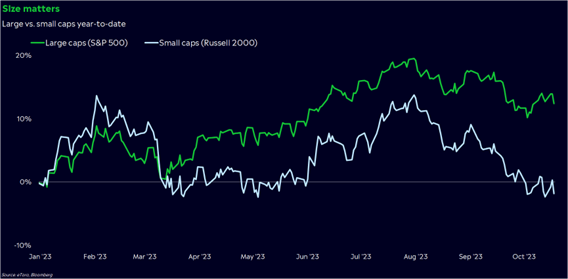We talk a lot about the S&P 500 — the index of the 500 largest stocks on the US market. And in doing so, we may be ignoring where high rates are hitting the hardest. Small-cap stocks — companies that are often $10 billion in size or smaller — have noticeably struggled this year compared to larger, more well-known companies, writes Callie Cox, US investment analyst at eToro.
It’s made this one-year-old bull market a bit awkward, considering that small caps have basically gone nowhere over the past year. As usual, they’ve got me thinking. Maybe the smallest stocks on the market are trying to tell us something.
These days, small-cap stocks like AMC Entertainment (AMC), Carvana (CVNA), and Big Lots (BIG) are capturing a big amount of attention for a bad reason. The Russell 2000 — a benchmark of small-cap stocks — is trailing the S&P 500 by 14 percentage points this year, heading for its worst annual performance versus the large-cap index in 25 years.

Market breadth — or the number of stocks actually rallying with the market — has been a concern all year. But small caps’ deterioration takes this concern to a whole new level. While smaller stocks are just a slice of the market, they’re typically more sensitive to ups and downs in the US economy. The two biggest industries in the Russell 2000 are industrials and banks, unlike the tech-dominated S&P 500.
Small caps have often been the first group of stocks to cave in the past, too. In the six recessions since 1980, the S&P 500 has peaked an average of three months before the economy has entered a recession. But the Russell 2000 has peaked before the S&P 500 in five out of six of those cases. If the stock market is a leading indicator, small caps are the leaders of that leading indicator.
Of course, this is why people are getting worried right now. Small caps typically don’t break away this much in a healthy, young bull market. Perhaps they’re warning us of risk ahead.
I think there’s some truth to this, even though it looks like we’re in a bull market. Interest rates are the biggest worry on investors’ minds, with the 10-year yield near 5% and the Federal Reserve eyeing several more months of aggressive policy.
However, the question may not be if the entire economy is on the precipice of a recession. It’s possible, but unlikely with unemployment this low. Instead, maybe we should be worried that certain parts of the economy — like America’s smallest companies — are on the edge.
So what does this mean for me?
Watch small businesses. We often focus too much on well-known, publicly traded companies while ignoring the small public and private businesses that make up a big portion of the economy. Small, unprofitable companies could be the most vulnerable to rising rates, and there may be enough pain to eventually weigh on the job market, your income, and your portfolio.
Look for quality. We’ve said for several months now that large, durable companies could benefit in a high-rate environment. Know how your investments make money and keep an eye out for signs of trouble in this earnings season.
Think opportunistically. I’m talking to the short-term, high-risk crowd here. If you think small caps could get crushed at large caps’ gain, think of ways that you can express that view in your portfolio. Options can be a good tool for complex views if you’re suited for them.




















